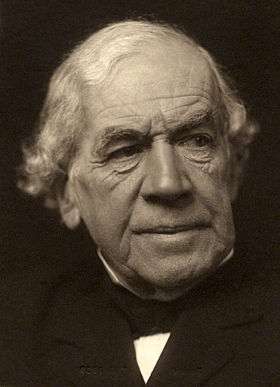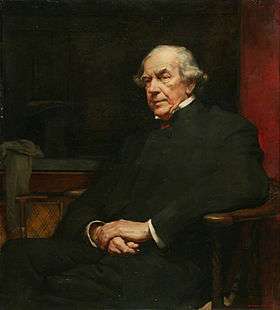James Staats Forbes
James Staats Forbes (7 March 1823 – 5 April 1904) was a Scottish railway engineer, railway administrator and art collector. He was the uncle of the painter Stanhope Alexander Forbes, and father of the zoologist William Alexander Forbes.
James Staats Forbes | |
|---|---|
 Sepia-toned platinotype of James Staats Forbes by George Charles Beresford, 1902 | |
| Born | 7 March 1823 Aberdeen, Scotland |
| Died | 5 April 1904 (aged 81) Chelsea, London |
| Nationality | British |
| Occupation | railway administrator, art collector |

 James Staats Forbes by William Orpen, 1900 |
Early life
James Staats Forbes was born on 7 March 1823 at Aberdeen, Scotland. He was the eldest of the six sons of James Staats Forbes and his wife Ann, née Walker. He went to school in Woolwich, and in 1840 was taken on as a draughtsman in the office of Isambard Kingdom Brunel, at that time chief engineer of the Great Western Railway. In 1841 Forbes joined the Great Western as a clerk, and in a short time rose to goods manager.
On 20 August 1851, Forbes married Ann Bennett; they had two sons and two daughters. She died in 1901.
Career
In 1857 Forbes went to the Netherlands to join the Dutch–Rhenish Railway, where he soon became general manager.[1] He was offered the position of general manager of the Great Western, but instead took over the failing London, Chatham and Dover Railway, then in receivership, where he was general manager and, from 1873, also chairman until in 1899 the company merged with the South Eastern Railway of Forbes's long-term rival, Sir Edward Watkin.[2]
On 6 October 1870 Forbes joined the board of the Metropolitan District Railway, also close to bankruptcy at the time, and was chairman from 1872 until 1901. He held many other board posts: he was chairman of the Edison and Swan Electric Light Company and two other electric light companies, president of the National Telephone Company, a director of the Lion Fire Insurance Company, a director of the Hull and Barnsley Railway, chairman of the Whitechapel and Bow Railway, and financial adviser to the Didcot, Newbury and Southampton Railway, which was at the time also in financial difficulties.[3]
He became an associate member of the Institution of Civil Engineers in 1865.[4]
Art collection
Forbes was a keen connoisseur of art, and built up a huge collection, particularly of works of the Barbizon School,[5] works of Jean-Baptiste-Camille Corot[5] and of nineteenth-century Dutch painters. He also had several paintings by James McNeill Whistler, including Blue and Silver: Boat Entering Pourville; Blue and Silver: Trouville; The Girl in Red; Grey and Brown: The Sad Sea Shore; Grey and Gold: High Tide at Pourville; Violet and Blue: The Red Feather and The Widow.[6] His collection consisted of over four thousand pictures and drawings, valued at over 220,000 pounds at the moment of his death.[7]
Following his death, his executors chose not to hold a sale of the whole collection, which would have taken a week and might have depressed prices, but instead to sell it in parts. Four hundred selected works were exhibited at the Grafton Galleries in 1905. The purchase of a large proportion of these by Abraham Preyer, including works by Théophile de Bock, Johannes Bosboom, Jozef Israëls, Hein Kever, Jacob and Willem Maris, Anton Mauve, Johannes Albert Neuhuys, Jan Hendrik Weissenbruch and others, was one of the largest art transactions then known.[8] The exhibition also included works by Jean-Baptiste-Camille Corot, Charles-François Daubigny, Narcisse Virgilio Díaz and Jean-François Millet.[9] A further exhibition was held in Brighton in 1908.[3]
Forbes died at his home, Garden Corner, 13 Chelsea Embankment, Chelsea on 5 April 1904.[6] He was buried at West Wickham in Kent five days later. James Forbes House, Southwark is named after him.
References
- Charlotte Shepherd (9 October 2008). "Cirencester's most famous son". Wilts and Gloucestershire Standard. Archived from the original on 18 February 2018. Retrieved 18 February 2018.
- Jane Onyanga-Omara (11 January 2013). "Tube 150th anniversary: Exploiting the 'suburban dream'". BBC News. Archived from the original on 18 February 2018. Retrieved 18 February 2018.
- Charles Welch (2004). Forbes, James Staats (1823–1904). Oxford Dictionary of National Biography. Oxford University Press. doi:10.1093/ref:odnb/33192. (subscription required)
- [s.n.] (1904). Obituary: James Staats Forbes. Minutes of the Proceedings of the Institution of Civil Engineers 158: 432–33.
- Massimo De Palma (2 May 2013). "Christie's: nell'asta 19th Century European Art Sale offerta una pittura pastorale recentemente scoperta" [Christie's: in the auction 19th Century European Art Sale offers a recently discovered pastoral painting]. Il Sole 24 Ore (in Italian). Archived from the original on 18 February 2018. Retrieved 18 February 2018.
- James Staats Forbes, 1823-1904. University of Glasgow: The correspondence of James McNeill Whistler. Accessed September 2013.
- Arrington, Lauren (2015). "The Politics of Art". Revolutionary Lives: Constance and Casimir Markievicz. Princeton University Press. p. 39. ISBN 978-0-691-16124-2 – via Google Books.
- [s.n.] (June 1905). postscript to Charles Henry Hart: "The Earliest European Artist in America". The Collector and Art Critic 3 (8): 117. (subscription required)
- [s.n.] (2006). Grafton Galleries Co Ltd University of Glasgow: Exhibition Culture in London 1878-1908. Accessed September 2013.
Further reading
- Charles Welch (1912). . Dictionary of National Biography (2nd supplement). London: Smith, Elder & Co.